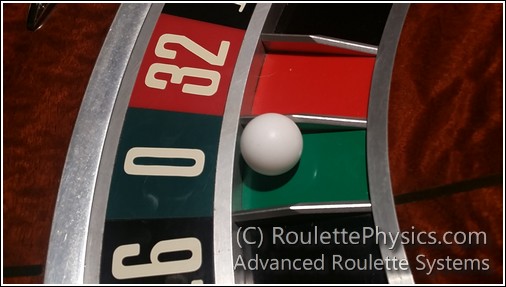Roulette was developed by a monk in the 1600s. The odds in favor of the house on most bests was determined to be 2.7 percent. When roulette came to America, a second green slot (the double zero) was added and the house edge grew to 5.26 percent in the United States. What this means is that while it is possible to have a hot streak, unless you find out how to increase roulette odds in your favor, you are ultimately going to lose your bankroll. The good news is that by using the physics of roulette, learning how to increase roulette odds is not only possible but relatively easy to do.
Start By Understanding How Roulette Odds are Calculated

Roulette is played on a wheel with 36 numbered red and black slots. On a European roulette wheel, a green “zero” slot is added, and on and American roulette wheel two green slots are added and labeled “zero” and “double zero”. On a straight bet of even/odd or red/black the chances of success would be 50/50, but with the green slots on the wheel the probability that you will win is 47.37 percent in America and 48.65 percent in Europe: 18 (the number of red/black or odd/even slots) divided by 37 or 38 (the total number of slots on the wheel). This means that over time you will statistically win about 47 to 48 spins out of 100 and the house will win 52 to 53. The house edge is calculated by subtracting the house’s winning percentage minus yours: 52.63 – 47.37 or 5.26 percent. Since the payout on these bets it even money, the odds are simple.
The same principal is applied to more complex bets. A single number bet pays out at 35 to 1. You win if your number is spun. The chances of that happening are 1 in 37 or 38 depending on the wheel. Dividing that out, in America you have a 2.63 percent chance of winning (2.7 percent in Europe) each time the wheel spins. Since you win 35 times your bet when your number hits, you multiply it out to get 35 x .0263 or .9205 minus the house win percent of .9737 (100 – 2.63) and you get .0526 or 5.26 percent: the standard house edge.
You Cannot Increase Roulette Odds Through Mathematics
Ever since the game was invented, people have tried, unsuccessfully, to beat the game through math. In fact, legend says that the monk who invented the game literally went crazy trying. Of course, just because you can’t do it does not mean that snake oil salesmen won’t try to sell you a “system”. The basic fallacy of all math systems come down to one key statistical point: every spin in roulette is independent of all others. This means that, mathematically, what happened before has absolutely no bearing on what will happen in the future.
If the wheel only had red and black slots you would have a 50/50 chance of spinning red. If red came up and the wheel was spun again, you would still have a 50/50 chance of hitting red. Even if red came up 5, 25, 300, 3,000 times in a row the very next spin would still come down to this: 18 red and 18 black equates to a 50/50 chance of spinning red. While logic tells us that eventually a black will be spun, that is different than saying there are increased odds that a black will be spun because of what happened on prior spins. Mathematically, each spin gives the house the same 5.26 percent advantage regardless of what happened on the spins before.
While science and math often go hand in hand, their basic premises are quite different, especially when approaching the roulette wheel. You will use math in your calculations, but your odds will not increase because of the math. What will increase your odds are the physical properties of the wheel, ball, and croupier. These physical traits can be measured through the science known as physics.
Using physics, there are several ways that you can predict where the ball will land and increase your odds of winning. Remember, when betting a single number, you have a 2.63 chance of winning. If you could increase that percentage by even 1 percent, you would have eliminated the house edge, and if your number were to be spun 4 to 5 percent of the time (which means the house could still win 95 to 96 percent of the spins) you would have an enormous advantage of 5 to 8 percent over the house (remember, single number bets pay out at 35 to 1). This would equate to thousands of dollars each day on even smaller bets.
Wheel bias, dealer signatures, and calculated ball bounce are all very real. Identifying them can be learned and mastered with a little work and practice, but nothing can beat the use of electronic assistance. After all, we can’t think and calculate as fast as a computer can, and calculating spin rates and ball bounce does involve some math. It is also important to note that not every wheel is biased and not every dealer has a signature that can be exploited. Learning to identify which wheels are beatable and which one provide enough of an edge to make play worthwhile is part of the process.
One thing is certain, however, through the physics of roulette, you can learn how to increase roulette odds in your favor and beat the house frequently enough to make an excellent living.
For further reading, I suggest how to win at roulette and how to play roulette as good starting points.
To get the best free roulette systems that really work, see the top 5 proven roulette systems and the video series below. It's the best 100% free information for winning roulette you'll find. It's written by professionals who are really earning a living from roulette. |

